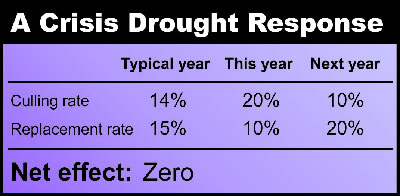
Kris Ringwall
Beef Talk
Understanding culling and replacement rates is critical.
Culling and replacement rates are the two numbers that will affect the base cow herd. These numbers are shifted as managers determine how to fit cattle to given resources. The rates are the foundation to expanding and contracting cattle numbers.
Knowing one's culling and replacement rates and relating those numbers to industry numbers is important. The North Dakota Beef Cattle Improvement Association (NDBCIA) keeps track of many traits for producers through the Cow Herd Appraisal Performance Software (CHAPS) program. Since 1990, the typical culling rate has been 14.1%, while the typical replacement rate has been 17.8%.
Optimistic replacement rates
For more than 20 years of the CHAPS program, producers have encountered many challenges in the beef business. If the word "optimistic" is correct, the most optimistic year resulted in replacing cattle at more than 21% of the herd, while more conservative times are reflected in a low replacement rate of just less than 15%.

The replacement rate is the number of bred replacement heifers or purchased cows that are kept. The culling rate is the number of cows that are removed from the herd. For more than 20 years, only once has the culling rate exceeded the replacement rate. In other words, through good times and bad times, producers are optimistic and have replaced at a greater percentage than they have culled.
Typically, for CHAPS herds, cull cows and bulls and market heifers make up approximately 50% of the annual paycheck, with 30% from the value of the heifer calves and 20% from the value of the cows and bulls.
What is interesting, at least at today's market values and using the CHAPS benchmarks, is that a 100-cow herd would sell 31 heifers and 14 cows. So, how do producers respond to drought once all the male calves have been sold or moved? The answer is in the ratio of replacement heifers and cull market cows. Do we need to keep the replacement heifers? Do we need to sell cull cows?
Female ratio
If we assign a value of $750 to market heifers and $1,000 to market cows and use those values to measure the impact of culling and replacement rates, we can calculate some impacts. In a typical year, a producer with 100 cows would sell 14 cows for $14,000 and 31 heifers for $23,250. This gives us a total of $37,250 in female cattle sales.
In a dry year, such as this year, producers minimize the replacement rate. Interestingly, producers already have minimized the replacement rate because they have been replacing cows at minimal rates for the last several years. Thus, the cows are getting older.
Historically, a 17% culling rate has been the high vs. the current 14% rate. This means an additional $3,000 worth (three cows) of potential income this fall. Because dry weather is harder on older and young cows, producers who have been keeping minimal replacement heifers will end up having to pay to let some old cows go and increase the replacement rate to maintain the same size cow herd.
Logically, given this year's lack of feed, the culling rate should go up and those older cows that have been retained should be sold. Consequently, if one doubles the culling rate, then keeping replacement heifers is critical. The industry cannot withstand simultaneous reductions in young and old cows.
A crisis drought response this year is to increase the culling rate to 20% by selling $20,000 worth of cows. The replacement rate would be cut 10% by selling 36 heifers, which would bring in $27,000. Doing so will drop the herd size by approximately 10% and reduce the need for feed.
Next year, the goal would be to decrease the culling rate to 10% and increase the replacement rate to 20% to bring back the number of cows to the desired 100 head.
A producer could generate $47,000 of female cattle sales this year and, if prices were to stay the same, only sell $10,000 of cows and $19,500 of heifers for a total of $29,500 in sales of females next year. As mentioned, female sales last year brought in $37,250. This year, it will be $47,000 and is projected to be $29,500 next fall, so the three-year average would be $37,917.
All in all, that's not bad for having saved 10% in cow costs, maintained the long-term cow herd size and slightly increased income.
May you find all your ear tags.
 Your comments are always welcome at www.BeefTalk.com. For more information, contact the North Dakota Beef Cattle Improvement Association (NDBCIA) Office, 1041 State Ave., Dickinson, ND 58601, or go to www.CHAPS2000.com on the Internet.
Your comments are always welcome at www.BeefTalk.com. For more information, contact the North Dakota Beef Cattle Improvement Association (NDBCIA) Office, 1041 State Ave., Dickinson, ND 58601, or go to www.CHAPS2000.com on the Internet.










